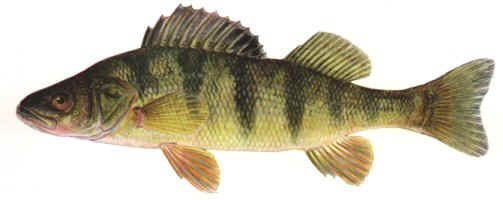Perca flavescens

YELLOW PERCH
Perca flavescens

Species overview: Yellow perch are native to the northern United States east of the Rocky Mountains and Atlantic Coast watersheds south to South Carolina. The genus name “Perca” means “perch,” and the species name “flavescens” means “yellow.”
Identification: Yellow perch have a long-looking body, but they are not as slim in appearance as other perch family species. The upper part of the head, back and sides is olive-green to golden-brown, shading to lighter yellow-green or yellow on the sides. The underside is white or grayish. Some back and side scales are dark and form a pattern of six to nine vertical stripes that narrow as they approach the belly. These stripes are a perch’s most distinctive feature. The pectoral, pelvic and anal fins are pale-yellow, becoming bright-orange on breeding-season males. The tail is slightly forked. The two dorsal fins are separated. The front dorsal fin has 13 to 15 sharp spines, and one or two spines can be found on the leading edge of the rear dorsal fin. The rest of the rear dorsal fin has soft rays. The anal fin has two spines, and there is a spine on the trailing edge of the gill cover, or opercle.
Habitat: Yellow perch live in a variety of aquatic habitats, including warm or cool lakes, ponds and sluggish streams. A prime yellow perch lake is cool and clear, with a sandy or gravelly bottom and rooted underwater vegetation. They also inhabit lakes with soft bottoms. Yellow perch are considered shallow-water dwellers and are not usually caught more than 30 feet deep.
Life history: Yellow perch spawn in spring, April and May, when water
temperatures are in the mid-40s to mid-50s. This is usually about a week after
walleyes spawn. Yellow perch males, which are smaller than females, move into
the spawning areas first. Selected spawning sites are five to 10 feet deep in
inland lakes, and over aquatic vegetation, submerged brush or along sand or
gravelly shorelines. Big female perch can produce up to 100,000 eggs, but most
produce 15,000 to 25,000 eggs. Spawning occurs at night and early morning. The
females are accompanied by several males, which swim alongside or behind them.
The eggs are deposited in a unique form–a long, sticky gelatinous mass
that drapes over underwater objects. The accordionlike transparent egg mass
absorbs water rapidly after it is emitted and swells, sometimes reaching seven
feet long and weighing up to two pounds. The egg mass is semi-buoyant and moves
gently with water currents and waves. Bad weather may cause the egg mass to
be torn up and washed onto land. Unlike the sunfishes, yellow perch parents
do not remain to guard the nest, eggs or young.
Yellow perch eggs take eight to 25 days to hatch, or longer. The hatching time
of these and other fish eggs depends on water temperature. Hatching takes longer
in cool water, a shorter time in warmer water. Newly hatched yellow perch head
for deep water, where they form free-swimming schools. After about a month,
they return to shallower water, and like the adults, live near the bottom. Young
perch feed on zooplankton and small aquatic insects, and in turn are food for
larger predator fish. Small fish, including small perch, are mainstays of the
adult perch’s diet. Adult perch also eat aquatic insects and crustaceans.
Yellow perch typically forage during daylight hours. They feed little or not
at all at night. They are active all year long, including under the ice, making
them a favorite with ice fishermen, who catch them on jigging rods and tip-ups.
Minnows and jigs are popular perch-getters.
In small lakes, yellow perch may overpopulate, resulting in stunted, slow-growing
fish. Perch commonly grow to 12 inches and may reach 14 inches. Even at a young
age, the females grow faster than the males, and as adults, they are larger.
Yellow perch sometimes travel in schools of from 50 to 200 individuals. The
schools stay in deeper, darker areas during the day and move closer to the shallows
to feed as evening approaches. Perch schools usually contain perch all of the
same size, which are also generally the same age, or year-class. At times males
and females roam in separate schools. In a lake, perch schools show migratory
movements according to the season and the time of day, in response to temperature,
food availability and spawning urge.